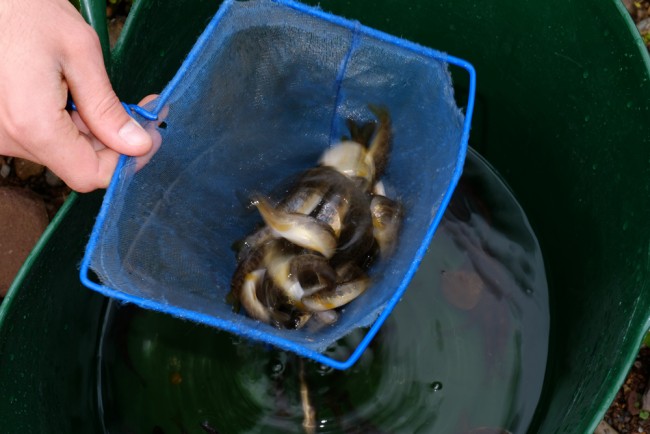After considerable time in planning and negotiations with SEPA, we finally commenced the work at Culroy on the Culroy Burn in the Doon catchment. This work is supported and funded by the River Doon District Salmon Fishery Board in an attempt to improve both water quality and habitat by reducing bank erosion. This section of the burn has been highly mobile in recent years and the landowner has lost tonnes of soil and valuable land.
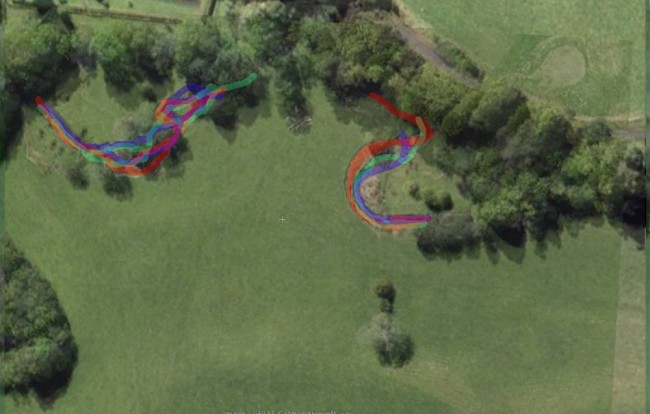
The different coloured lines indicate changes in the course of the burn in the last 15 or so years. This image is made up of 3 satellite images taken several years apart
CAR licences were issued by SEPA following a meeting on site earlier in Spring to agree what work was acceptable and the methods we would use. SEPA’s diffuse pollution and engineering specialists met with us and were broadly supportive. A CAR licence was applied for and issued. SEPA are keen to hold an ‘Engineering event’ following completion of the work to encourage farmers and anyone else interested, to come along and see what can be achieved using the least amount of hard engineering in conjunction with greener techniques. Our approach is low key intervention designed to bring big rewards. Improved water quality, reduced siltation, bank stability, shade, improved fish cover, spawning habitat and opportunities. Ambitious but hopefully achievable. Of course by reducing erosion and improving the habitat and bank stability, the ultimate goal is to increase salmon and sea trout stocks within the tributary. In recent years, this once prolific burn has failed to produce as many salmon as it should.
I’ve put together reports from each day that the Trust were on site. (The fencing will follow on over the next week or so).
Day 1 (Tuesday 1st Sept)

The start of day 1 as the machine prepared to start work on the main area of erosion. Cattle are responsible for the erosion below the tree but in the last year they have been excluded by a temporary electric scare fence. Prior to that, bank side erosion was driven by livestock.
The Culroy project started today with fencer Jim Thompson from Maybole arriving first closely followed by Jim, the machine and driver from Jamieson Plant Hire. We came last but with a trailer of hand tools attached and ready for something a bit different!
After a quick discussion of what was required, Muir, Struan and I set about removing the fish from the vicinity of the works (purely as a precautionary measure to protect them from any possible harm). We really don’t expect to be in stream with the machine at all but we did place a boulder or two so it was an 20 minute job worth doing. A total of 21 salmon, 42 trout and 4 eels were relocated a short distance downstream (stone loach and minnows also featured heavily). Not a terrible result but not good either considering the area involved.
The machine driver was astounded as he couldn’t see any fish before we started. That’s called education!! This project is all about establishing improvements and providing a demonstration site for local farmers etc. to see alternative ways how things can be done and how effective a low budget approach to engineering can be.
We’ve been taking time-lapse photos every minute and plenty of stills to record the work. Once this is edited we will post a link to the video.
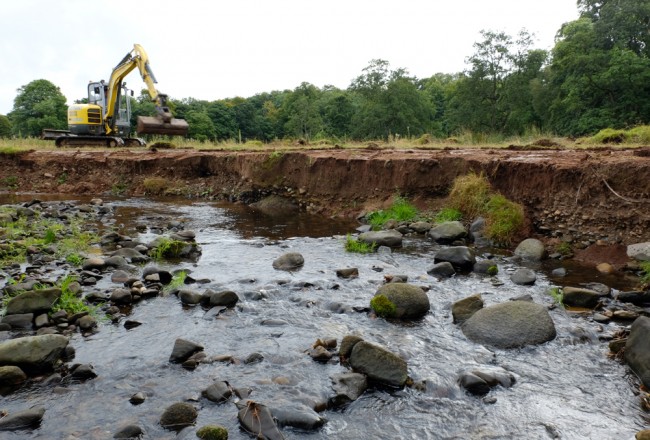
A 4′ high vertical bank that’s eroding quickly. The machine driver stripped the turf and set it aside for reuse later before starting to reprofile the bank
The machine started stripping the turf and setting it aside for reuse. Once this was complete along the most severe erosion, the vertical bank was regraded to between 30 – 40 º. Left over top soil is being moved to fill other areas of erosion by cattle. Rather than leave the site bare overnight in case it rained, we decided to relay the turf ahead of installing some large woody timber and deflectors on the bend. We plan to do this tomorrow. At least one section will also be treated with willow spilling, perhaps more if possible. We are planning to use as many techniques as possible to show what works best and how little things can make a difference.
Trees and limbs were felled today and the fencing is going up at a good rate elsewhere on this farm so we were all looking forwards to day 2 and another productive day.
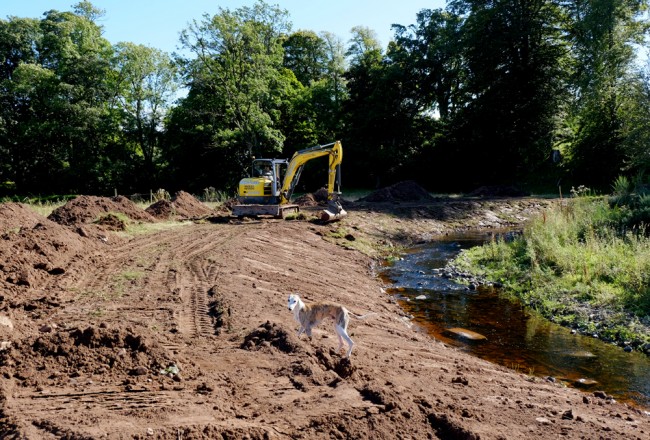
By the end of day 1, we had made good progress regrading the bank and relaying the turf. Thankfully the machine was on hand to do the hard work
Day 2
The day started overcast and damp so we were pleased that the turf had gone back on last night. Anyway we pushed on with a bit of willow harvesting (on site) and then installed a short stretch of woven willow spilling to reinforce the upper section of the regraded bank. After this was quickly completed, we planted a variety of willow cuttings into that section of the bank (we prepared these in the last couple of weeks, they were collected locally).

Struan was busy weaving willow whips between stakes driven in the toe of the bank. These will hopefully root quickly to provide a living revetment. Muir set about pushing willow cuttings and planting a few self seeded birch trees into the bank
The landowner was busy moving excess soil with his old Fegusson 135 and trailer; slow but sure! This soil is being used to fill dips in his field.
We moved to the lower section that we were to tackle, where the burn has again taken metres of the bank away and changed course repeatedly in the last decade. Again we stripped the turf then set it aside for reuse, then reprofiled the bank. We also remove a large tree stump just upstream that had lodged mid stream causing the channel to split leading to bank erosion. This caused a bit of silt to be released instream but we had protection 2 pools below that proved quite effective.
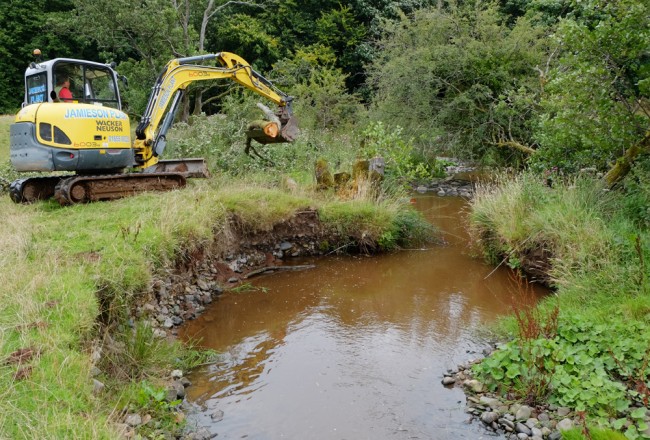
The lower section where the burn was cutting into the bank further each year. The Alders trees were coppiced and rather than replanting as we hoped, we decide to leave it in place as it was still well rooted despite being undermined. The felled Alder trunks were used elsewhere for bank reinforcement and flow deflection
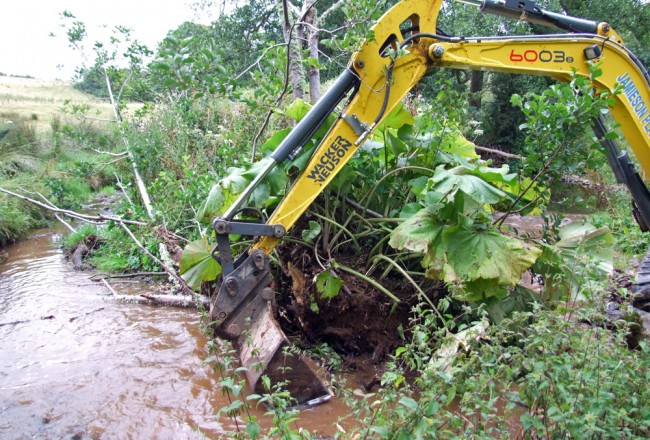
A large tree stump was removed that had lodged mid stream causing the burn to split and erode a new channel. Hopefully the river will redistribute some of the sediment that has built up behind the obstruction
Next we placed a full length of Alder against exposed clay to help deflect water from this bank. Not to push the water away but just to stop or slow the rate of erosion. The tree was wired into poison and attached to an 8 foot post driven into the bank so it should never move in a spate. Just a few metres downstream on the bend where erosion has been a major issue, we inserted two upstream deflectors that should turn water away from the bank especially as the water rises, thus protecting the bank. In the lower section we again installed willow spilling to try and protect the large multi-stem Alder that we coppiced for timber. It is partly undermined and we had planned to replant it elsewhere but it was still well attached and we though it may last for some time if our work upstream is effective so it was left in place. 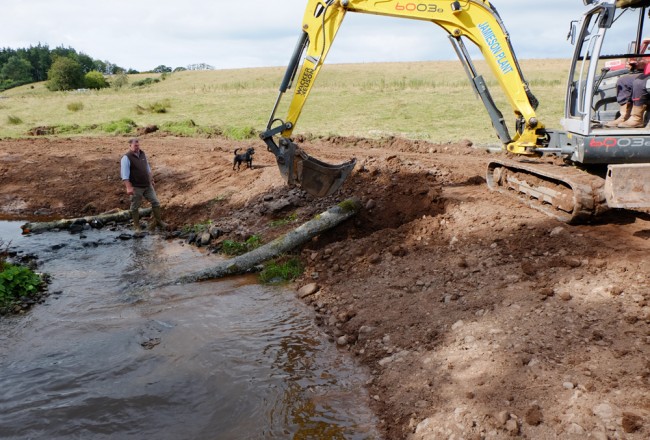
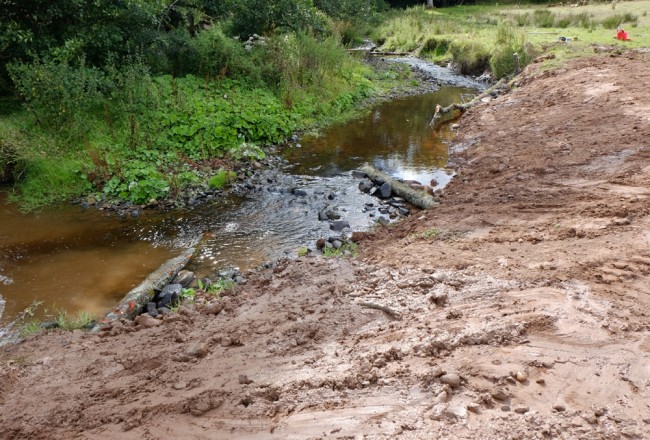
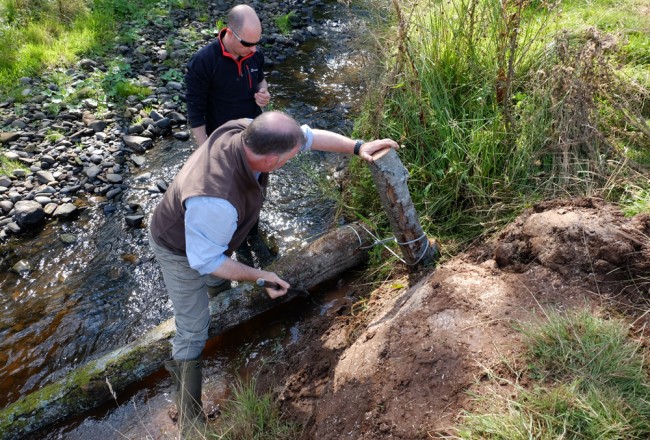
Positioning and securing a long tree trunk against a section of bank where clay was being eroded. This tree was wired in place then staked so it can’t wash out in a spate
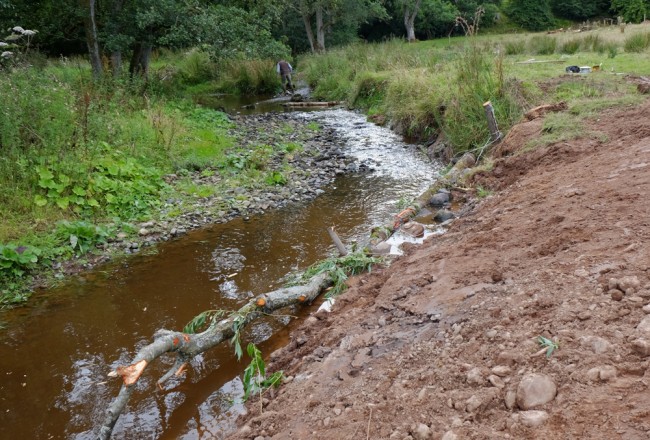
Turf will be replaced and this bank will be planted with willow cuttings. The roots should help prevent further erosion taking place one they are established
Time beat us and we didn’t get the turf back on this evening but we left the silt protection in place and will turf it first thing in the morning. Tomorrow is a day we hadn’t budgeted for but we have saved a bit on the fencing so will hopefully manage to keep close to the estimate.
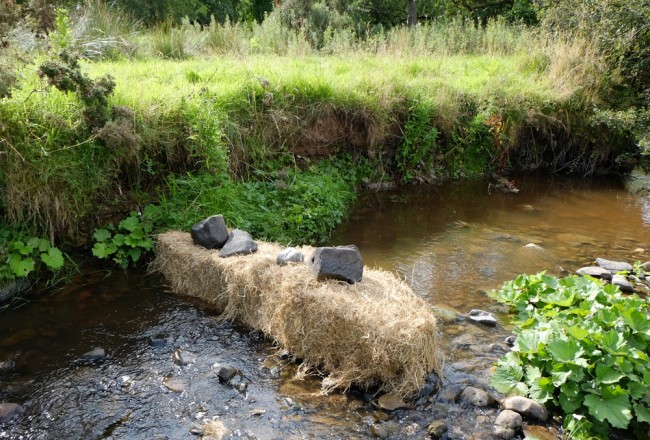
Simple silt protection measures were very effective and we left them in place overnight as we hadn’t relaid the turves by the end of the day.
We still have a drain to install where cattle poaching has long been a problem and after that, we will install a few more upstream deflectors to try and narrow and deepen areas where the burn has become over wide. After that we will clean up and leave the excess soil for the landowner to move at his convenience. The fencer will follow and hopefully this job will be a great success. Time will tell but already I’m wishing away the years as I expect to see a big improvement in water quality and habitat and ultimately the fish population.
Day 3
This was the last day with the machine and ART staff on site, but the fencer has another week’s work, or thereabout.
Today with the banks graded and re turfed, willows planted and spilling in, there wasn’t much left for us to do this afternoon but to add a few more deflectors. These simple timber defectors are installed for different reasons; to change the direction of flow, reduce erosion, create scour, clean gravel, create pool or spawning habitat etc. There’s several ways to do this but it’s easier with the machine and this allowed us to bury the ends deep in the bank so they shouldn’t move for years. Upstream facing deflectors are designed to turn water away from the bank and we felt these used on the outside of the eroding bends would reduce erosion in future. In another area where flow was very slow, we installed a pair of these, one on each bank. This should cause scour and concentrate flows, hopefully deepening the pool and cleaning the gravel which was very silty as sediment dropped out of suspension in the slack flow. It may also narrow the pool through deposition upstream of the deflectors. Each situation is different and care has to be taken not to increase problems rather than solve them. We will monitor and fine tune our deflectors if necessary. As they are made of timber, they can easily be cut out if they fail to produce desired results or problems.
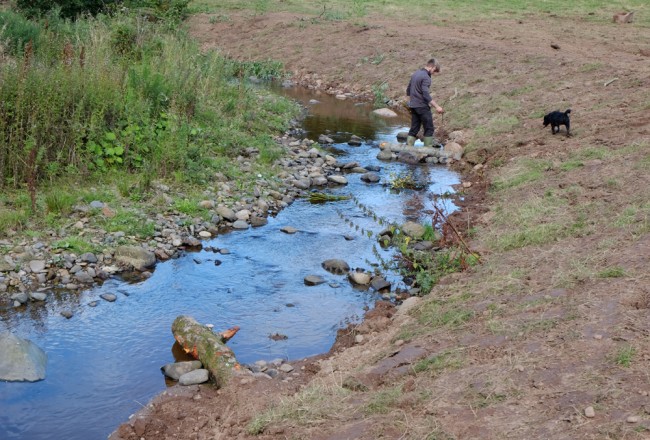
Timber deflectors in place along the previously eroding banks, the last job left at this point was to plant the willow cuttings on the slope to help stabilise it in future
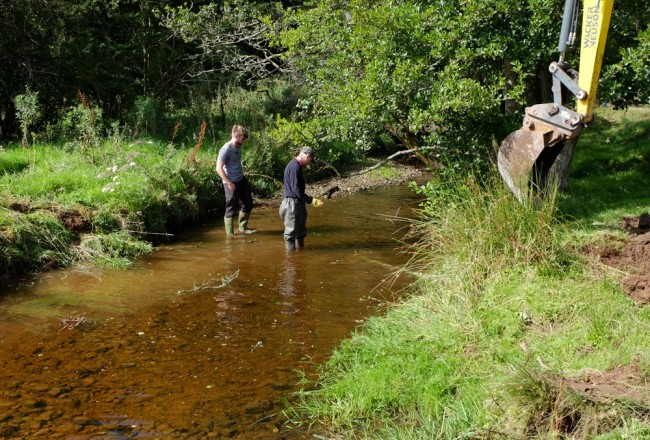
A pair of upstream deflectors that will hopefully cause scour, narrow the burn and clean and sort spawning gravel. The silt disturbed by Struan and Muir’s feet is typical of this burn and exactly the sort of problem that we are trying to address with this work. There another problem area upstream causing silt issues in the burn and are hopeful that this area can be addressed too but await SEPA’s update on progress with the landowner. It is only the regulator that can force change where it is necessary.
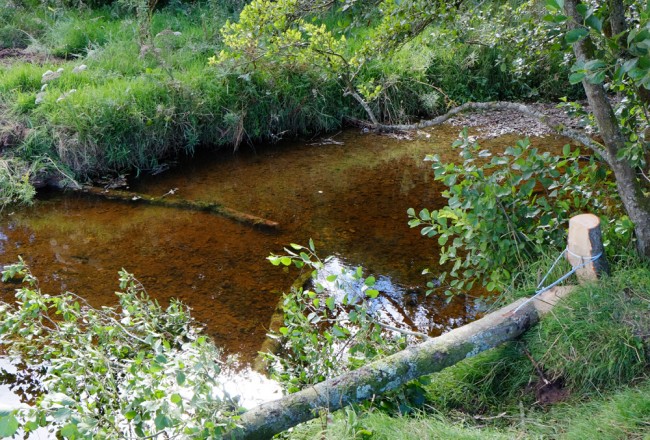
A pair of upstream deflectors in place. In the foreground is an Alder stem dropped by the bank but still attached to the tree and alive. A wire rope also provides added security show it become detached. Hopefully this continue to grow and provide cover for fish among the branches that each the water.
Elsewhere we secured fallen trees against eroding banks to provide a simple form of erosion control. We felled stems but left them attached with a ‘hinge’ so they remain living. These are designed to provide fish refuge and habitat.
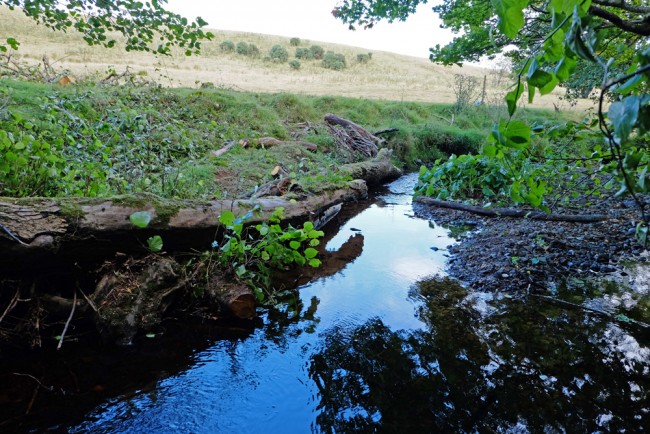
Very Large woody debris that has been in the river for years and provides bank protection. We moved it slightly to improve the level of protection then cleared other timber that threatened to cause problems. The landowner has firewood to cut for the winter.
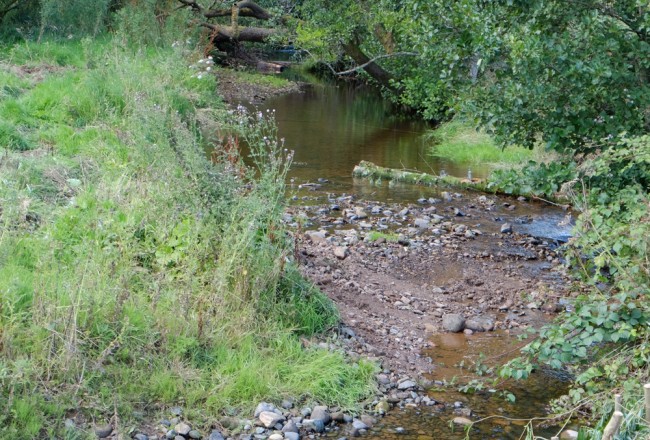
One point where we did use the machine to ease a problem in the river was in this image. There was a large build up of dry sediment on the bank and we felt this only led to increased erosion and undercutting.. Removing dry gravel is permissible so we did but only a minimal amount.. By adding an upstream deflector just above this point, we aim to turn the flow across to where the shingle build up, hopefully keeping it clear in future (this will work in higher flows). This should reduce the force of the flow that undermines the bank and slow erosion.
Over the 3 days we’ve also removed some of the worst log jams, and where possible we used the timber elsewhere on site in the many different approaches we’ve taken. All left over timber will be used by the owner for firewood.
After a quick tidy up we headed off leaving the landowner and machine man to finish off repairing the blocked drainage system. This will reduce silt reaching the burn caused by cattle poaching the wet areas. Grass seed and more plants will be added shortly and the fence once its up, will protect the banks and the plants from livestock. Excess top soil (about 40 tonnes) has been piled for reuse later. It’s hard to imagine just how many thousand tonnes of soil have been lost from this area in the time I’ve been with the Trust but there have been significant changes. Hopefully things will stabilise now.
Most of the work we have been doing has been hand work, which is slow but it has been rewarding and I’m looking forwards to seeing the results in the next spate and over the coming years.
We have asked SEPA to assist by encouraging a landowner further upstream to correct similar livestock driven issues where much of the silt arises but I’m not filled with expectation as that was months ago and we haven’t heard anything yet. Lets’s hope some pressure is placed on those responsible. These issues reduce water quality and fish spawning success on this burn and I’m very keen to help if we can, as I expect the Doon DSFB will be but we need the regulator’s assistance to drive this forwards.
